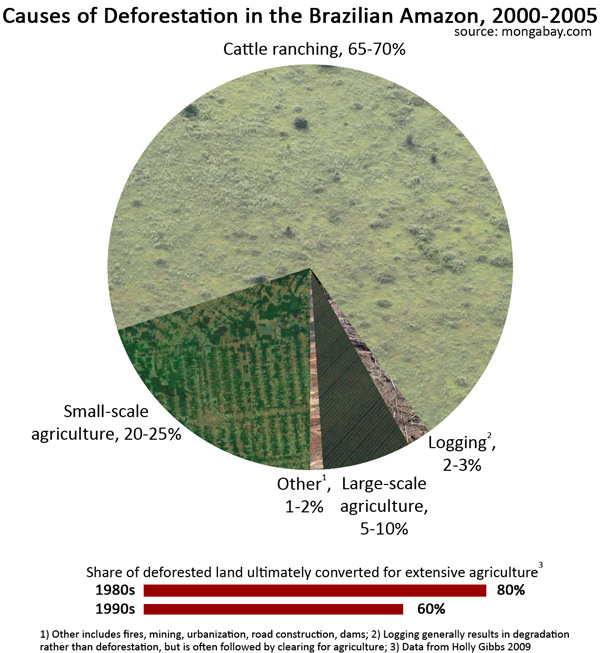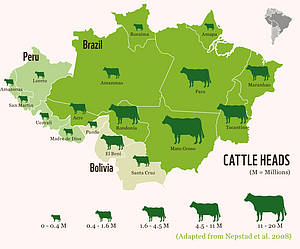Could your trip down to the neighborhood meat market, or your favorite burger joint be contributing to the demise of the Amazon rainforest? Cattle ranching in Brazil is the leading cause of deforestation in the Amazon. This is old news though. Cattle ranching has been the leading cause of deforestation in the Amazon rainforest since the 70s. The cattle industry in Brazil is responsible for 80% of the deforestation of the Brazilian Amazon region to be exact. This means that the ever growing cattle sector in Brazil is also a huge contributor to the greenhouse effect. According to Greenpeace, statistics show that 2.5 acres of the rainforest is destroyed every 18 seconds. To compound the situation, the number of cattle in Brazil has nearly doubled since 1990. Back in the 90s, Brazil only produced enough beef to feed its own population. Today, the cattle production industry, located in the heart of the Amazon on a territory known as Mato Grosso, has increased by at least 50 billion. Here in Mato Grosso, pasturelands have been cleared for cattle grazing the size of Portugal!
Recently, Brazil has also just earned itself the title of largest beef exporter in the world, exporting everywhere from Hong Kong, the European Union, and even to the United States (primarily fast food restaurants). According to the Center for International Forestry Research, ‘between 1990 and 2001 the percentage of Europe’s processed meat imports that came from Brazil rose from 40-75 percent’ and by 2003 for the first time ever, ‘the growth in Brazilian cattle production—80% of which was in the Amazon—was largely export driven.’
The United States has recently been in dispute with Brazil over the cotton production industry, and (thank heavens!) placed a ban on the import of Brazilian beef…but hold on folks: that ban is set to expire at the end of this year. Another important note to consider: this ban on Brazilian beef imports is not a complete ban, in fact, many restaurants and other fine dining businesses in the US continue to partake in the destruction of the Amazon. The ban only pertains to grocery stores, and is currently in debate as to whether or not it will be lifted. The ban depends upon the dispute over cotton production industry between the two countries. The ban was originally instated in the US due to the high levels of foot and mouth disease prominent in Brazilian beef.
Foot and mouth disease is an infectious, and sometimes fatal, viral disease that affects cloven-hoofed animals. The virus causes a high fever for two or three days, followed by blisters inside the mouth and on the feet that may rupture and cause lameness. Foot-and-mouth disease is a severe plague for animal farming, since it is highly infectious and can be spread by infected animals through aerosols, through contact with contaminated farming equipment, vehicles, clothing or feed, and by domestic and wild predators. Its containment demands considerable efforts in vaccination, strict monitoring, trade restrictions and quarantines, and occasionally the elimination of millions of animals. But once the ban is lifted this year, there’s no telling how much of our beef will be imported from Brazil.
Fast food restaurants like McDonald’s are veterans when it comes to buying their beef from Brazil, and they aren’t the only ones either! It is estimated that the making of a McDonalds Quarter-Pounder destroys 55 square feet of the endangered rainforest. So roughly speaking, this plot of land that the ever so juicy burger annihilated contains on average 1 giant tree, 50 smaller trees, 20-30 different tree species, over 100 species of insects, as well as birds, mammals, and reptiles. The United States does import their beef from other sources, like companies in Australia as well as Canada, but since these places have been decreasing their production numbers as a result of the global recession, the US is left with few options. The United States simply does not have enough lean meat sources in the domestic market to feed the population and must resort to relying on the import market (like Brazil) to make up the difference.
So what can you do to help? Many people have no idea where any of their food comes from, let alone their meat. Tapping into resources that allow you to lead a more informative lifestyle when making decisions at your local grocery store is a great start. Learning where your meat comes from and how it is raised, and only buying local or less is another option. Then again, you could always just go cold turkey, no meat, no worries…no pun intended!




